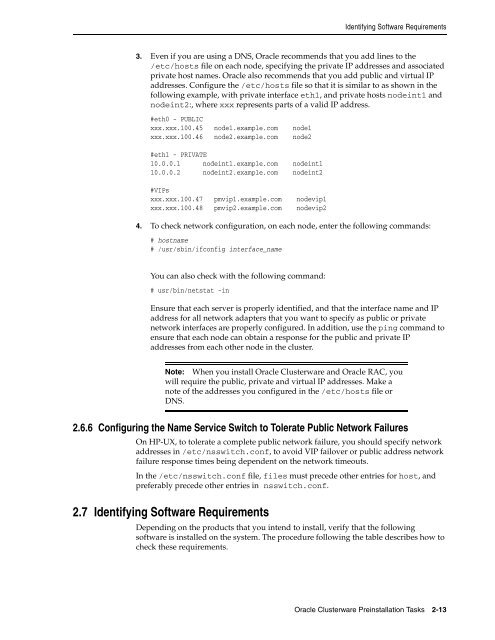Oracle Database Oracle Clusterware Installation Guide for HP-UX
Oracle Database Oracle Clusterware Installation Guide for HP-UX
Oracle Database Oracle Clusterware Installation Guide for HP-UX
Create successful ePaper yourself
Turn your PDF publications into a flip-book with our unique Google optimized e-Paper software.
Identifying Software Requirements<br />
3. Even if you are using a DNS, <strong>Oracle</strong> recommends that you add lines to the<br />
/etc/hosts file on each node, specifying the private IP addresses and associated<br />
private host names. <strong>Oracle</strong> also recommends that you add public and virtual IP<br />
addresses. Configure the /etc/hosts file so that it is similar to as shown in the<br />
following example, with private interface eth1, and private hosts nodeint1 and<br />
nodeint2:, where xxx represents parts of a valid IP address.<br />
#eth0 - PUBLIC<br />
xxx.xxx.100.45 node1.example.com node1<br />
xxx.xxx.100.46 node2.example.com node2<br />
#eth1 - PRIVATE<br />
10.0.0.1 nodeint1.example.com nodeint1<br />
10.0.0.2 nodeint2.example.com nodeint2<br />
#VIPs<br />
xxx.xxx.100.47 pmvip1.example.com nodevip1<br />
xxx.xxx.100.48 pmvip2.example.com nodevip2<br />
4. To check network configuration, on each node, enter the following commands:<br />
# hostname<br />
# /usr/sbin/ifconfig interface_name<br />
You can also check with the following command:<br />
# usr/bin/netstat -in<br />
Ensure that each server is properly identified, and that the interface name and IP<br />
address <strong>for</strong> all network adapters that you want to specify as public or private<br />
network interfaces are properly configured. In addition, use the ping command to<br />
ensure that each node can obtain a response <strong>for</strong> the public and private IP<br />
addresses from each other node in the cluster.<br />
Note: When you install <strong>Oracle</strong> <strong>Clusterware</strong> and <strong>Oracle</strong> RAC, you<br />
will require the public, private and virtual IP addresses. Make a<br />
note of the addresses you configured in the /etc/hosts file or<br />
DNS.<br />
2.6.6 Configuring the Name Service Switch to Tolerate Public Network Failures<br />
On <strong>HP</strong>-<strong>UX</strong>, to tolerate a complete public network failure, you should specify network<br />
addresses in /etc/nsswitch.conf, to avoid VIP failover or public address network<br />
failure response times being dependent on the network timeouts.<br />
In the /etc/nsswitch.conf file, files must precede other entries <strong>for</strong> host, and<br />
preferably precede other entries in nsswitch.conf.<br />
2.7 Identifying Software Requirements<br />
Depending on the products that you intend to install, verify that the following<br />
software is installed on the system. The procedure following the table describes how to<br />
check these requirements.<br />
<strong>Oracle</strong> <strong>Clusterware</strong> Preinstallation Tasks 2-13
















